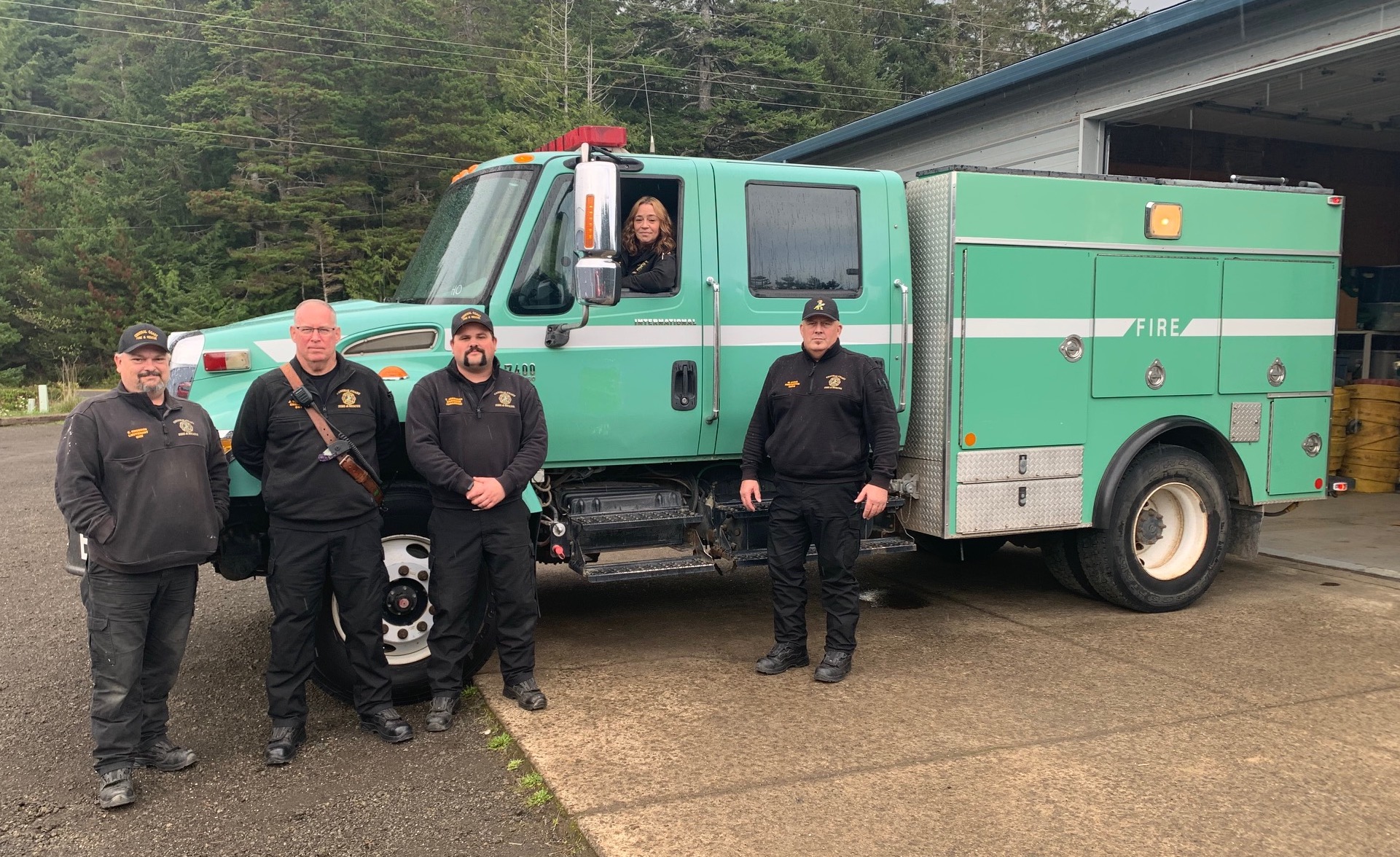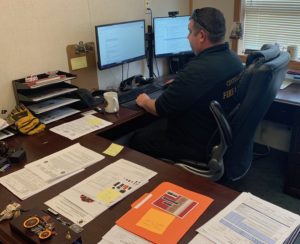
By GARRET JAROS/YachatsNews
WALDPORT – Viewing the job of a fire chief from afar can look pretty appealing, especially when harkening back to the imprint of childhood – bright red trucks polished to an impossible shine, flashing lights and sirens, water-cannon hoses and axes to extinguish fires while saving lives – with only the occasional slow day to rescue cats from treetops.
The reality however, what makes all those other aspects possible, kind of lands with a dull thump.
“The majority of my time is spread between supervising operations, monitoring budgets and applying for grants,” said Central Oregon Coast Fire & Rescue District chief Jamie Mason. “That’s literally my day to day.”
Romanticized visions aside, what is remarkable in that ‘thump’ is Mason’s efforts to chase down grants, which over the last two years has led to Central Coast getting $900,000 worth of equipment.
Some fire departments are diligent at pursuing grants and some are not. But Mason believes that every one should be.
“They should be hitting every grant they possibly can because every grant you get is just a little bit that makes your district better without your public footing the bill,” said Mason, who has been with Central Coast since 2020 after eight years with North Lincoln Fire & Rescue. “Grants are always good. Anytime I get a grant that’s equipment that the public doesn’t have to pay for.”
The neighboring districts of Yachats and Seal Rock have also received state wildfire grants and smaller outlays from the Siletz Tribal Charitable Contributions Fund, but have not landed the larger grants that Central Coast has received.
COCF&R’s 2023-2024 budget is $1.5 million. It’s actual tax-based income is $1.1 million with another $400,000 in cash carryover that rolls over each year to carry the district from July to November when property taxes come in.
Central Coast staff responded to 1,100 calls last year — an average of 3.5 a day. Like most fire departments, 80 percent of those were medical responses.
Mason’s pursuit of grants came with the support of the district’s previous board, which had three former members who had conflicts with the chief on other issues, and the current board, who support him strongly.

Without the equipment acquired through grants there is no telling how COCF&R would update or add to its equipment while already on a tight budget, Mason said.
“The biggest budget challenge right now is everything is increasing in cost and I’m working off a 2012 budget,” Mason said.
A tax rate for operations approved by voters in 2012 is $1.27 per $1,000 assessed property value. The general fund also pulls in 82 cents per $1,000 from a permanent tax base. And then there is a serial levy that was bumped up last year from 25 cents to 35 cents per $1,000 to try to keep up with increased operational costs.
That’s a total of $2.44 per $1,000 assessed property value to pay for the fire district’s yearly operations – or $732 a year on property assessed at $300,000.
The $1.27 operations levy pays for most staffing costs, which accounts for Mason and nine full-time employees. In 2016 COCF&R board decided to stick with that $1.27 levy, and then again in 2020 because of the impact the pandemic was having on jobs and taxpayer’s pocketbooks.
“So the 2025-2026 budget year will be the first opportunity we have to get our budget to current terms with the economy,” Mason said. “So our biggest issue is the fact that the monies that we receive now are based off the economy that was set in 2012. So we are trying our best to make those monies work until we can get to the next levy rotation.”
The problem is that it’s a “very bad thing to do perception-wise” but when you let a levy go that long without being increased you paint yourself into a corner where then all of a sudden you have this really big increase and everybody wonders “What the heck?” and “Where did that come from?” Mason said.
The district has been tightening its belt while operations’ costs have steadily increased each year, Mason said. But that belt is now cinched as tight as it will go.
Except for two summertime state wildfire grants to cover extra firefighters on overtime or to hire temporary help, there are no grants to cover operational costs.
And while grants do go toward acquiring equipment, they don’t pay for the maintenance of the equipment. And the Central Coast truck fleet is having maintenance issues. The newest vehicle in the district’s fleet, aside from staff vehicles, is from 2009 and the oldest is from 1989. Grants also don’t cover ever-increasing fuel costs.
Forest Service brush engine
The silver lining has been the district’s pursuit of grants.
Most recently, the district acquired a used Type-3 heavy brush engine valued at $175,000 through a U.S. Forest Service excess property program. It will be stationed in Tidewater. Next year the district will get a tender — valued at $467,000 – via a grant from the State Fire Marshal’s Office. It will also be stationed in Tidewater.
Multiple grants are in play now – one to get watercraft drone that can be deployed to reach people quickly. It also serves as a flotation device and has the capability to communicate with the person. Another request is in play to get a jet ski through a state program.
In addition to the fire marshal’s and Siletz tribal grants, a partial list of grant sources Mason has tapped include the Oregon Emergency Management Office; Gary Sinise Fund; Oregon Health & Science University; Oregon Department of Forestry; Leary Firefighters Foundation; and Firehouse Subs. He also plans to reach out to the Confederated Tribes of Grand Ronde and the Confederated Tribes of Coos, Lower Umpqua and Siuslaw.
And yet, despite Mason’s grant success, there is still the big fish that escapes his net year after year.
“We’ve applied for the last three years through the Federal Emergency Management Agency to try to get brand new vehicles and all three years we’ve been denied,” Mason said. “These are assistance to firefighter grants. It’s common to apply for either equipment or vehicles.”
He applied unsuccessfully the last two years for a Type-1 engine and last year for a new tender. COCF&R asked for a $650,000 fire truck to serve a population of 4,000, Mason said, while fire districts in more populated areas are applying and getting a $1 million ladder truck to serve a population of 2.5 million.
Central Coast board member Jon MacCulloch praised the chief and staff’s ability to track down grants.
“He goes out and finds this money,” MacCulloch said. “He knows all the ins and outs to go to the various agencies and apply for grant money.”
And while Mason is the focal point, staff like firefighter John Townley and Eric and Wendy Knudson, “scrub every conceivable area to find specific money for specific uses” so the district does not have to go back to the taxpayers with a ballot measure to raise money for an operations levy, MacCulloch said.
“It’s key that we are able to utilize virtually every tool we can to capture money to give the people what they need,” MacCulloch said. “They want good fire service and we’re determined to give them good fire service. And a lot of that plays into how much we have in the bank account to bring ourselves up into the modern world.”
- Garret Jaros is YachatsNews’ full-time reporter and can be reached at GJaros@YachatsNews.com



Thanks for this detailed story! It helps to understand the levies better. We are really lucky to have such a great crew keeping us safe, and making every dollar count.